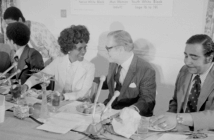Leaders need to be ready to deal with change, says Jim Cowart. But it’s important to recognize the difference between the church’s mission, which is unchanging, and methods, which must often be updated to serve the age-old mission.
Change doesn’t have manners and rarely knocks. Instead, it comes barreling in, giving us little time to react. And if we stand in its path long enough trying to decide what to do, we are run over by the wheels of change. Leaders need to be ready to deal with change.
The church’s mission is unchanging
Before you get up in arms about me trying to change your church, let me clarify a bit. There is a huge difference between mission and methods. The mission of the church doesn’t change. In fact, we can’t change the mission of the church because it’s not our church. It’s God’s. And God’s mission, communicated through the life of Jesus, is fully contained in two summary statement we label as the Great Commandment (love God and love your neighbor) and the Great Commission (make disciples) to keep us on task. The church must always be faithful to the Great Commandment and the Great Commission. We can’t vote on it. We don’t need a meeting to revise it. The mission is set.
The church’s methods must change
But methods are different. Methods need to change. In fact, they must change in order to carry out the mission among new generations. Methods don’t have the same status as mission. New methods — new ways to do things — are similar to new technologies and new strategies.
If the church doesn’t see the need to adapt its methods, doesn’t know how to adapt its methods, or refuses to adapt its methods, then a chasm will appear between a church and its culture, and it will be run over by change. It will become ineffective in completing its mission.
How do you handle change?
Are you open to new ideas, new methods, and new technology? I’m not quick to answer “Yes,” but I’m working on it. And I think it’s a little harder now than when I was younger.
When we started a new congregation in 2001 in southern Georgia, it was considered an innovation. We were the first in our area to use technology, play contemporary music, and use skits and testimonies as part of the message. That doesn’t sound very innovative now; tens of thousands of churches do this. We’re not new anymore. Innovation has a shelf life. Now as a maturing organization, we face the challenge of change, that of balancing two sometimes opposing elements, holding onto the core values that must never change while being open, flexible, and innovative with our methods.
Danger is imminent when leaders migrate to one of two extremes about change because either can throw a church out of balance. Some leaders tend to chase whatever new fad comes along. If social media is touting it, and other churches are trying it, they jump on board. On the other end of the spectrum, some leaders would rather die than change anything. In their view, to change seems like disloyalty to people who came before them and to systems or traditions that they feel called to preserve. Both extremes are out of balance.
Even as you remain faithful to God’s mission for the church, it is possible for change to overwhelm your vision and stamina. Find a healthy balance and pace. Don’t fear change. But don’t chase too hard after it either.
It is foolish to conclude that “old = bad” and “new = good.” That polarization is just not the case with tradition or innovation. Sometimes the old ways are better. But the old methods often must be updated to keep moving toward the age-old mission.
Related Resources
- Discovering God’s Future for Your Church Video Tool Kit
- Why Some Ministries Need to Die by Graham Standish
- Choose Your Hills Wisely by Jim Cowart







